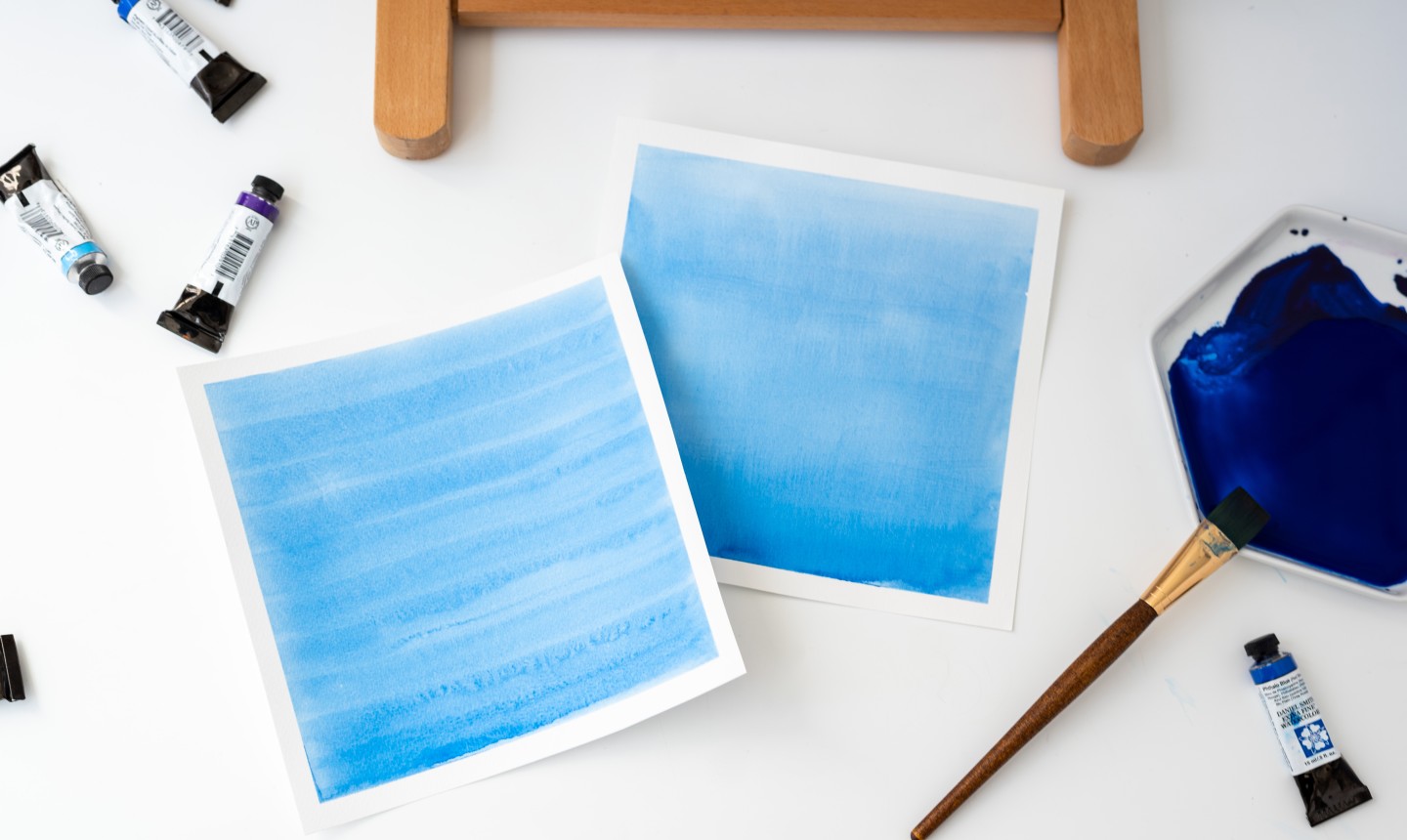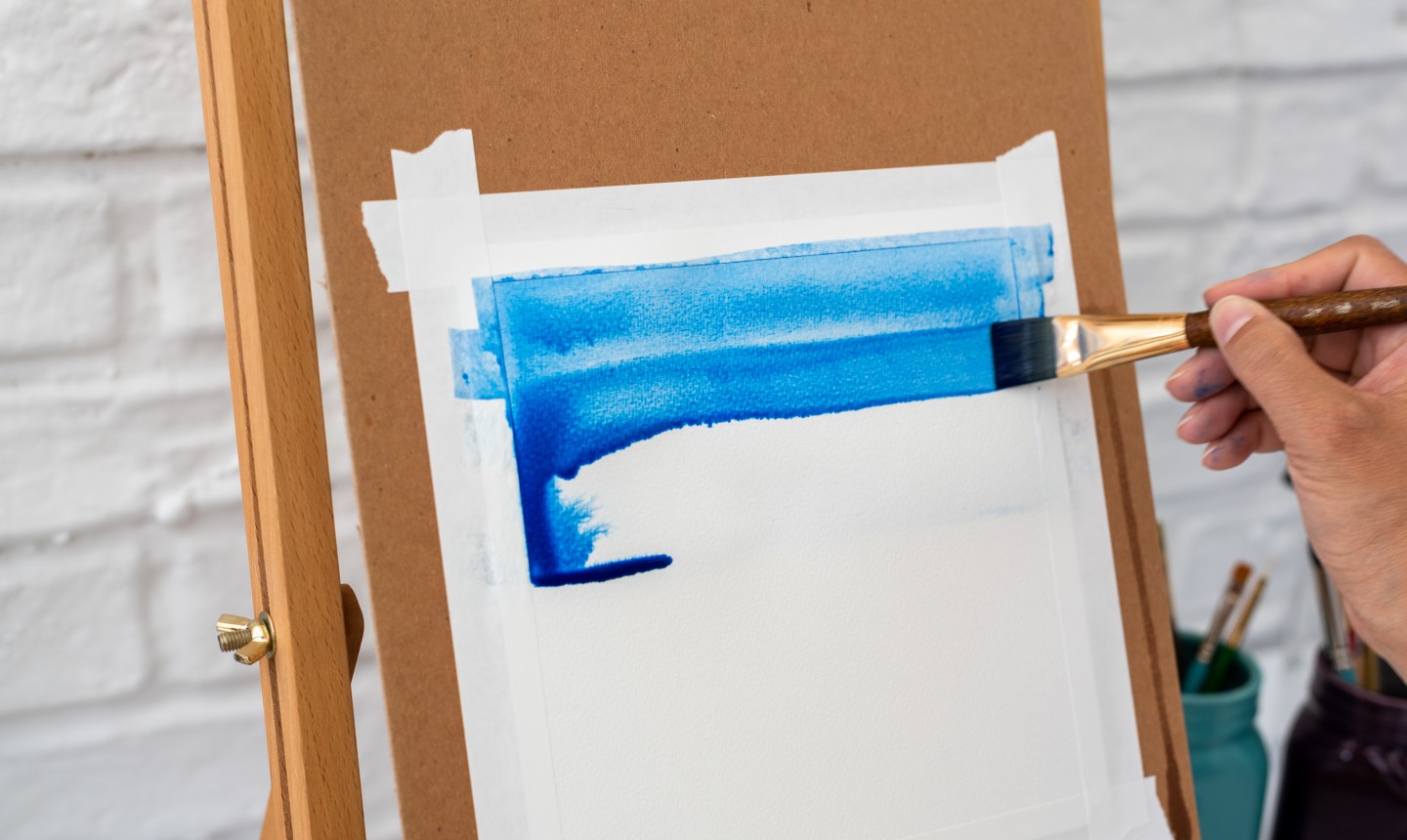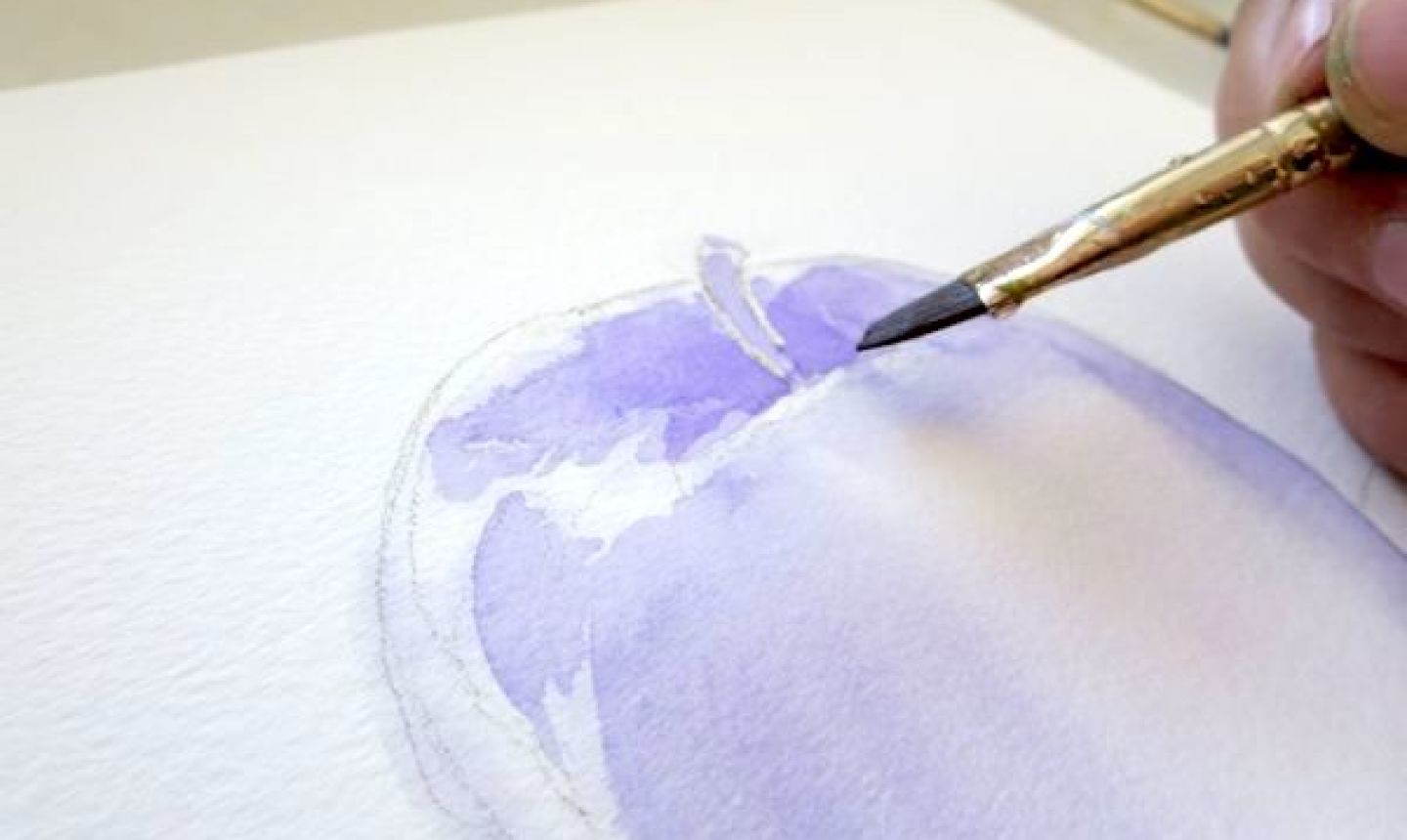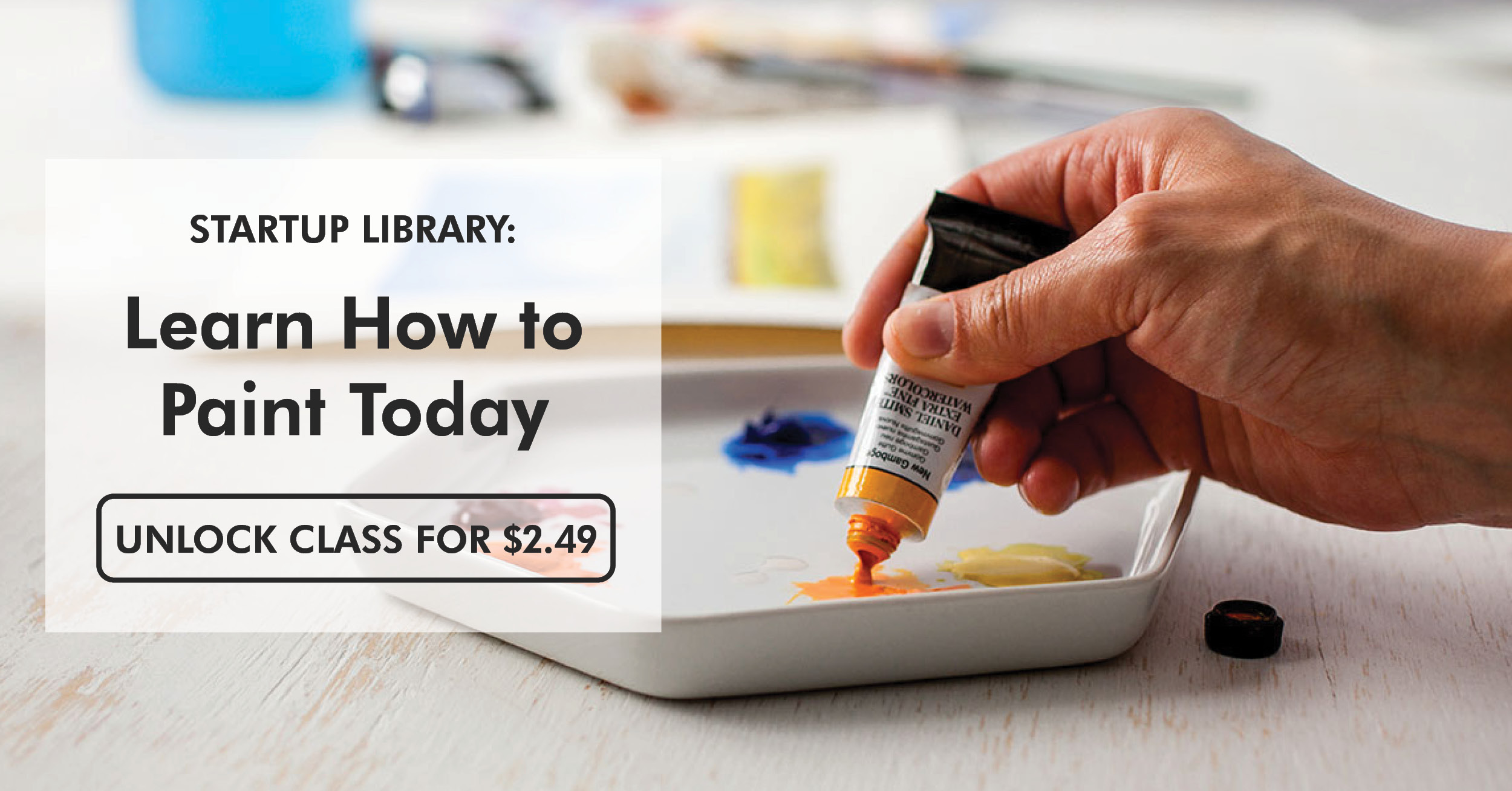1. Watercolor Washes
There’s more than one way to approach laying a watercolor wash — you can do it either on a wet surface or a dry one. One tip for any watercolor wash: If you notice a mistake in a previous stroke, don’t try to fix it. Once the wash has started to dry, a new stroke will almost definitely be more noticeable than any small mistake. It’s best to leave these happy little accidents as they are.
Dry Wash
Use a large flat or round brush and an angled surface like a drafting table or easel (this way, gravity does some work for you.) On your palette, mix a generous amount of water with your chosen pigment. Remember that watercolors dry lighter than they look when they’re wet. You might want to practice on a scrap of watercolor paper first.Load your brush with as much paint as it’ll hold. Then, working quickly, make a steady, controlled horizontal stroke along the top of the paper. You’ll notice the water in the first stroke starts to pool along the bottom edge — don’t let this dry! Reload your brush with pigment and paint another stroke just below the first one, overlapping with the bottom edge.
When you reach the bottom, blot your brush on a paper towel, then use the dry tip to carefully pull up the excess paint along the bottom of the final stroke to avoid a darker bottom. Let your paper dry completely at an angle before setting it down flat again.

Wet Wash
A wet surface watercolor wash is about the same as a dry wash, with one main difference: First you’ll dip your brush in water and brush it over the whole surface. Be generous with the water here — you want the paper glistening with moisture.Once you’ve wet the area, dip the brush in paint and apply lines of color within the wet area, just like you would with a dry wash. The paint will blend together into one luminous wash of color.

2. Wet-In-Wet Watercolor Painting
Wet-in-wet painting is one of the most basic techniques — so basic you might have already done it before without realizing it!Start by brushing water (and only water) onto your paper. Then dip your brush in paint and spread it over the water wash. The paint will feather and diffuse like magic.
3. Underpainting
An underpainting is essentially a monochrome wash that’s used for the first layer of the painting. You’ll add layers of transparent washes over the underpainting, which gives realistic and luminous effects.First, mix a light purple shade (a combo of cadmium red and ultramarine blue works great). Neutral shades of blue or green can also work.
Lightly paint your subject using the purple, and pay careful attention to light and shade. Since you’re only working in one color, you can really focus on rendering the shape. Use a soft brush and a light hand to keep the purple from overpowering the rest of the painting.
Let the underpainting dry completely before moving on to glazing in color. If it’s wet, you might muddy your colors.

4. Gradients and Color Blending
A simple watercolor wash uses just one color, but you can add depth to your work by using more hues in a gradient. Start by adding fresh watercolor to a wet paint surface.Then place the second color — either a more intense version of the same hue or a different hue entirely — right beside the first color.
Because the paints are on a wet surface, they’ll blend slightly and create a natural gradient in the tones. You can control how neat or painterly a gradient comes out by the wetness of the paint.

5. Layering Watercolors
Once a color of paint has dried, you can add layers of watercolor to create dimension, texture and color variation. Just know that the paper has to be completely dry in between washes so that the colors don’t blend together and get muddy.Wait until your initial color has dried completely (not damp — dry!), then paint the second color on top. Just don’t add much water to the second color since this can re-wet the initial color and make the two blend.
To make the lines of your second color less severe, you can wet the brush with water and brush gently to feather the line.

6. Dry Brush
Dry brush painting requires using very little paint and water to create a scratchy, “scraped-across” brushstroke. It can be used for an entire painting, but it’s also perfect for creating texture in small areas of a larger painting.Mix your pigment, making sure your paint mixture is not super wet. Dip your dry brush into the paint, dab it onto a paper towel to remove the excess, and brush lightly across the surface — this method highlights the texture of the paper and also doesn’t muddy your colors.
7. Lifting Color
In some cases, you’ll want to remove pigment from your painting. This is especially handy when you’ve made a mistake or when you want to add white space to your work. Using different techniques, you can lift color from wet or dry watercolor.Lifting from Wet Watercolors
If your paint’s still wet, it’s easy to remove pigment. Blot your brush thoroughly and touch it to the paint to lift it back off the paper. The trick here is that the damp-but-blotted brush absorbs more water than it releases, so it’ll quickly pick the wet color up from your painting.Another option is to use a paper towel or tissue paper to lift the pigment. These tools can be the better choice if you’re going for a more abstract, less-controlled white space. If you want more control, use a brush.
Lifting Dry Watercolor
You can also lift pigment off the page even if the paint’s dry, though it’s a little more difficult. Believe it or not, this can be pretty effectively done with a simple eraser.For a little more control, start by wetting the area with water, then use a stiff, nearly dry brush or a paper towel to lift the color.

8. Watercolor Blooms
Watercolor blooms or blossoms like these happen when very wet paint spreads on a drier (but not completely dry) area of a painting. When you apply wet paint on a still-damp wash, the liquid forces the original pigment out, and it creates these fun, irregularly shaped splotches.First, lay down a colorful wet wash and let it dry a little. Then load your brush with water and touch it lightly to the paper. The drops of water will create sharply defined blooms. How dry the underlying wash is determines the hardness of edges.
You can also do the same thing with two colors: Apply the first and let it dry a bit. Then apply a wet wash of a different color right next to the first one, so that they come in contact. The wetter of the two washes will flow into the other.

9. Back Washes
This technique is similar to watercolor blooms because it requires a certain level of dryness to get the look. Apply a wet wash of color and tilt the surface a little. The color should drift to one side of the painting area. Then set the surface down flat. As the water dries, it bleeds upward again and creates a back wash.
10. Feathering
If you’re going for a gradient that goes from a saturated color to a more transparent hue, adding more paint won’t do the trick. What you need is water. Start with a strong area of color and then use a clean, wet brush to “diffuse” the color, making a gentle gradient or “feathering” effect.
11. Lines, Hatching and Crosshatching
Watercolor can be used to paint lines of any size, shape and thickness. Just like with pen and ink drawings, you can place lines beside each other or layer them perpendicular to each other for a hatching or cross-hatching effect.For clean lines, use a small, pointed brush and load it with pigment, using only a dash of water. Then, paint a line on your paper. Depending on how much water you add to the brush, you can get dark, crisp lines or flowy, freeform lines.

12. Scumbling
Scumbling is a technique where irregular motions are used to make either a line or layer on paint. It’s basically like scribbling with your brush. Don’t think too hard about it: just paint irregularly in an area. To really see the texture, use a relatively dry brush.
13. Stippling
Instead of applying lines or areas of paint, stippling is painting tiny dots in a concentrated area. Once you’ve painted many dots, you’ll have a saturated color and fascinating texture.Stippling can be neat and tidy, or the marks can overlap in a more freeform way. You can use a fairly dry brush for more defined dots or a wet brush for a looser look. And of course, the size of the brush you choose will determine the size of your dots, so choose carefully.

14. Splattering
Hello, Jackson Pollock. Splattering gives your painting an energetic vibe, but it’s easier said than done — this technique can easily get messy and uncontrollable. But there are three approaches to making splattering more approachable.The Tapping Method
Fill the bristles of your paintbrush with pigment. Then, either with your fingers or a second brush, gently tap the pigment-filled paintbrush over your paper. That will give the paint enough force travel across your canvas and cover a lot of ground. But keep in mind that this method makes the paint more difficult to control.The Flicking Method
For more control over your splatter, you’ve gotta get your hands dirty. Load a stiff-bristled brush (or a spare toothbrush, if you have one) with pigment and hold it in one hand at a downward angle, so the bristles are pointed toward the ground. Then, with your opposite hand, slowly run your fingers along the edge of the brush, pulling the bristles back so that they launch paint onto the canvas.Make a Stencil
For ultimate control over your splatter paint, make a stencil. It’s simple — just cut a shape from a large sheet of paper and place it over your canvas before splattering paint.
15. Sponge Painting
A textured sponge can be a very handy tool to paint everything from foliage in trees to sand on a beach. You can use a sea sponge or a regular new household sponge; just dip it into your pigment and press it to your paper.16. Adding Texture with Salt
When salt is sprinkled on a wet wash, it starts to gather the watercolor pigments and makes the coolest texture. The effect will vary depending on the size of the grains of salt and the wetness of the paper, so experiment on scraps of watercolor paper before you commit on your final painting. Once the paint is dry, simply brush off the excess salt.Looking to get started with watercolors? Check out the class Startup Library: Watercolors below!



I mask with rubber cement. Sometimes with colors under and then layer over and more layering of paint. I also use rubber cement to keep white space.
Hello, Sillah here ,just a fellow artist trying to inspire and teach as many aspiring artists. Below I have written a blog that explore insane watercolor techniques currently being used in 2023. Do check it out ! https://artiststrove.000webhostapp.com/2023/04/insane-watercolor-techniques
Learn to paint
could I get a copy of watercolor techniques
It was all cool. A few of the technics I did in the 1980s.
Very interesting informations
Good tips and illustrations
very intrested
Wonderful ideas with pictures to go along with the instructions Thank you craftsy.
These are all great tips. Thanks 😊